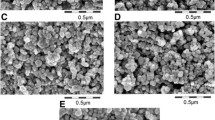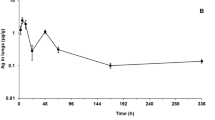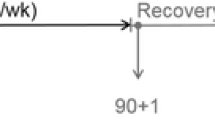Abstract
There is much contradiction between different experimental studies on beryllium (Be) toxicity. The majority of studies focus on occupational pathologies, caused by the exposure to Be dust. However, Be pollution may affect wide population groups through other exposure routes. The discrepancies between experimental studies may be attributed to the lack of adequate Be toxicity model since conventional administration routes are hampered by high acidity and low solubility of Be compounds. This study was aimed to develop a novel way to implement Be toxicity avoiding side effects, related to high acidity or low solubility of Be salts. Intraperitoneal injection of Be–glycine composition (containing BeSO4, glycine, purified water, pH adjusted to 5.5 with NaOH) was tested in the dose range 238–7622 µmol Be kg−1 (body weight, b/w) in full-grown Wistar male rats. The model provided reliable uptake of Be from the peritoneum into general circulation for at least 48 h. LD50 was found to be 687 µmol Be kg−1 (b/w). The established LD50 value differed from previous data on gastrointestinal, intramuscular or intravenous administration of Be compounds. The liver was found to act as a primary elimination route for Be and related to the highest Be content in the animal. However, it had no signs of morphological damage, which was observed only in the testes (deterioration of germinal epithelium). At the same time, the lungs, stated as a primary target tissue for Be in the models of chronic beryllium disease, did not show strong Be accumulation nor morphological changes. Survived animals showed behavioral changes, including increased motor activity and aggressive reactions in some cases, and complete spasticity in other. The obtained data show the applicability of the established modeling protocol and testified for the independence of chronic beryllium disease on Be2+ ion toxicity per se.





Similar content being viewed by others
References
Alekseeva OG, Vasil’eva EV, Orlova AA (1974) Abolition of natural tolerance and the influence of the chemical allergen beryllium on autoimmune processes. Bull WHO 51(1):51–58
Attia SM, Harisa GI, Hassan MH, Bakheet SA (2013) Beryllium chloride-induced oxidative DNA damage and alteration in the expression patterns of DNA repair-related genes. Mutagenesis 28(5):555–559. https://doi.org/10.1093/mutage/get032
Bowerman NA, Falta MT, Mack DG, Kappler JW, Fontenot AP (2011) Mutagenesis of beryllium-specific TCRs suggests an unusual binding topology for antigen recognition. J Immunol 187(7):3694–3703. https://doi.org/10.4049/jimmunol.1101872
Cherry N, Beach J, Burstyn I et al (2015) Genetic susceptibility to beryllium: a case-referent study of men and women of working age with sarcoidosis or other chronic lung disease. Occup Environ Med 72(1):21–27. https://doi.org/10.1136/oemed-2014-102359
Clayton GM, Wang Y, Crawford F et al (2014) Structural basis of chronic beryllium disease: linking allergic hypersensitivity and autoimmunity. Cell 158(1):132–142. https://doi.org/10.1016/j.cell.2014.04.048
Costas-Rodríguez M, Delanghe J, Vanhaecke F (2016) High-precision isotopic analysis of essential mineral elements in biomedicine: natural isotope ratio variations as potential diagnostic and/or prognostic markers. TrAC Trends Anal Chem 76:182–193. https://doi.org/10.1016/j.trac.2015.10.008
Cummings B, Kaser MR, Wiggins G, Ord MG, Stocken LA (1982) Beryllium toxicity. The selective inhibition of casein kinase 1. Biochem J 208(1):141–146. https://doi.org/10.1042/bj2080141
Drobyshev EJ, Solovyev ND, Ivanenko NB, Kombarova MY, Ganeev AA (2017) Trace element biomonitoring in hair of school children from a polluted area by sector field inductively coupled plasma mass spectrometry. J Trace Elem Med Biol 39:14–20. https://doi.org/10.1016/j.jtemb.2016.07.004
Drobyshev E, Dagaev S, Ivanenko N et al (2018a) Method for beryllium intoxication simulation. Russian Federation, Patent RU 2641380, 17.01.2018
Drobyshev EJ, Solovyev ND, Gorokhovskiy BM, Kashuro VA (2018b) Accumulation patterns of sub-chronic aluminum toxicity model after gastrointestinal administration in rats. Biol Trace Elem Res 185(2):384–394. https://doi.org/10.1007/s12011-018-1247-8
Drolet-Vives K, Zayed J, Sauvé S (2009) Assessment of hair and bone accumulation of beryllium by mice exposed to contaminated dusts. J Appl Toxicol 29(7):638–642. https://doi.org/10.1002/jat.1448
Ellis PD (2010) The essential guide to effect sizes: statistical power, meta-analysis, and the interpretation of research results. Cambridge University Press, Cambridge
Fahmy MA, Hassan NHA, Farghaly AA, Hassan EES (2008) Studies on the genotoxic effect of beryllium chloride and the possible protective role of selenium/vitamins A, C and E. Mutat Res Genet Toxicol Environ Mutagen 652(2):103–111. https://doi.org/10.1016/j.mrgentox.2007.12.009
Falta MT, Pinilla C, Mack DG et al (2013) Identification of beryllium-dependent peptides recognized by CD4 + T cells in chronic beryllium disease. J Exp Med 210(7):1403–1418. https://doi.org/10.1084/jem.20122426
Grew ES (ed) (2002) Beryllium: mineralogy, petrology, and geochemistry. Mineralogical Society of America, Washington DC
Groth DH (1980) Carcinogenicity of beryllium: review of the literature. Environ Res 21(1):56–62. https://doi.org/10.1016/0013-9351(80)90008-0
Gu J (1997) Analytical morphology. Theory, applications and protocols. Birkhäuser Boston, Cambridge
Hamada C (2018) Statistical analysis for toxicity studies. J Toxicol Pathol 31(1):15–22. https://doi.org/10.1293/tox.2017-0050
Harber P, Bansal S, Balmes J (2009) Progression from beryllium exposure to chronic beryllium disease: an analytic model. Environ Health Perspect 117(6):970–974. https://doi.org/10.1289/ehp.0800440
Hard GC, Skilleter DN, Reiner E (1977) Correlation of pathology with distribution of Be following administration of beryllium sulfate and beryllium sulfosalicylate complexes to the rat. Exp Mol Pathol 27(2):197–212. https://doi.org/10.1016/0014-4800(77)90030-2
Hau J, Schapiro SJ (2010) Handbook of laboratory animal science: essential principles and practices, vol 1. CRC Press, Boca Raton
Hulo S, Radauceanu A, Chérot-Kornobis N et al (2016) Beryllium in exhaled breath condensate as a biomarker of occupational exposure in a primary aluminum production plant. Int J Hyg Environ Health 219(1):40–47. https://doi.org/10.1016/j.ijheh.2015.08.003
IPCS/WHO (1990) International programme on chemical safety. Environmental health criteria 106: beryllium. World Health Organization, Geneva
Ivanenko NB, Solovyev ND, Ivanenko AA, Ganeev AA (2012) Application of zeeman graphite furnace atomic absorption spectrometry with high-frequency modulation polarization for the direct determination of aluminum, beryllium, cadmium, chromium, mercury, manganese, nickel, lead, and thallium in human blood. Arch Environ Contam Toxicol 63(3):299–308. https://doi.org/10.1007/s00244-012-9784-1
Ivanenko NB, Ivanenko AA, Solovyev ND, Zeimal AE, Navolotskii DV, Drobyshev EJ (2013) Biomonitoring of 20 trace elements in blood and urine of occupationally exposed workers by sector field inductively coupled plasma mass spectrometry. Talanta 116:764–769. https://doi.org/10.1016/j.talanta.2013.07.079
Johri S, Shrivastava S, Sharma P, Shukla S (2004) Analysis of time-dependent recovery from beryllium toxicity following chelation therapy and antioxidant supplementation. Indian J Exp Biol 42(8):798–802
Kim KW, Kim D, Won YL, Kang SK (2013) Effects of beryllium on human serum immunoglobulin and lymphocyte subpopulation. Toxicol Res 29(2):115–120. https://doi.org/10.5487/TR.2013.29.2.115
Kolanz ME (2001) Introduction to beryllium: uses, regulatory history, and disease. Appl Occup Environ Hyg 16(5):559–567. https://doi.org/10.1080/10473220119088
Kreiss K, Day GA, Schuler CR (2007) Beryllium: a modern industrial hazard. Annu Rev Public Health 28:259–277
Mathur S (1994) Role of Liv-52 in protection against beryllium intoxication. Biol Trace Elem Res 41(3):201–215. https://doi.org/10.1007/BF02917423
Mathur R, Sharma S, Mathur S, Prakash AO (1987) Effect of beryllium nitrate on early and late pregnancy in rats. Bull Environ Contam Toxicol 38(1):73–77. https://doi.org/10.1007/BF01606561
McCleskey TM, Buchner V, Field RW, Scott BL (2009) Recent advances in understanding the biomolecular basis of chronic beryllium disease: a review. Rev Environ Health 24(2):75–115. https://doi.org/10.1515/REVEH.2009.24.2.75
Michalke B, Willkommen D, Drobyshev E, Solovyev N (2018) The importance of speciation analysis in neurodegeneration research. TrAC Trends Anal Chem 104:160–170. https://doi.org/10.1016/j.trac.2017.08.008
Morgan BJT, Williams DA (1996) Statistics in toxicology: a volume in memory of David A. Williams, vol 3. Clarendon Press, Oxford
Mudireddy SR, Abdul ARM, Gorjala P, Gary RK (2014) Beryllium is an inhibitor of cellular GSK-3β that is 1,000-fold more potent than lithium. Biometals 27(6):1203–1216. https://doi.org/10.1007/s10534-014-9783-y
Newman LS, Bobka C, Schumacher B et al (1994) Compartmentalized immune response reflects clinical severity of beryllium disease. Am J Respir Crit Care Med 150(1):135–142. https://doi.org/10.1164/ajrccm.150.1.8025739
Penner GE (1980) Acid ingestion: toxicology and treatment. Ann Emerg Med 9(7):374–379. https://doi.org/10.1016/S0196-0644(80)80116-8
Petukh M, Wu B, Stefl S et al (2014) Chronic beryllium disease: revealing the role of beryllium ion and small peptides binding to HLA-DP2. PLoS One 9(11):e111604. https://doi.org/10.1371/journal.pone.0111604
Prakash AO, Mathur S, Mathur R (1986) Effect of feeding gymnema sylvestre leaves on blood glucose in beryllium nitrate treated rats. J Ethnopharmacol 18(2):143–146. https://doi.org/10.1016/0378-8741(86)90026-7
Robinson FR (1973) Toxicity of beryllium and other elements in missile propellants. Clin Toxicol 6(3):497–502. https://doi.org/10.3109/15563657308990546
Sharma P, Johri S, Shukla S (2000) Beryllium-induced toxicity and its prevention by treatment with chelating agents. J Appl Toxicol 20(4):313–318. https://doi.org/10.1002/1099-1263(200007/08)20:4%3C313::AID-JAT660%3E3.0.CO;2-J
Solovyev N, Vinceti M, Grill P, Mandrioli J, Michalke B (2017a) Redox speciation of iron, manganese, and copper in cerebrospinal fluid by strong cation exchange chromatography–sector field inductively coupled plasma mass spectrometry. Anal Chim Acta 973:25–33. https://doi.org/10.1016/j.aca.2017.03.040
Solovyev ND, Fedoros EI, Drobyshev EJ et al (2017b) Anticancer activity and tissue distribution of platinum(II) complex with lignin-derived polymer of benzene-poly-carboxylic acids. J Trace Elem Med Biol 43:72–79. https://doi.org/10.1016/j.jtemb.2016.11.009
Strupp C (2011) Beryllium metal I. Experimental results on acute oral toxicity, local skin and eye effects, and genotoxicity. Ann Occup Hyg 55(1):30–42. https://doi.org/10.1093/annhyg/meq071
Tinkle SS, Antonini JM, Rich BA et al (2003) Skin as a route of exposure and sensitization in chronic beryllium disease. Environ Health Perspect 111(9):1202–1208. https://doi.org/10.1289/ehp.5999
Witschi HP (1970) Effects of beryllium on deoxyribonucleic acid-synthesizing enzymes in regenerating rat liver. Biochem J 120(3):623–634. https://doi.org/10.1042/bj1200623
Zhao W, Ding L, Gu X et al (2015) Levels and ecological risk assessment of metals in soils from a typical e-waste recycling region in southeast China. Ecotoxicology 24(9):1947–1960. https://doi.org/10.1007/s10646-015-1532-7
Acknowledgements
The study was partially supported by the Russian Science Foundation, Grant no. 18-73-00055.
Author information
Authors and Affiliations
Corresponding author
Ethics declarations
Conflict of interest
The authors declare that they have no conflict of interest.
Ethical approval
All procedures of the study involving animals were approved by the Local Bioethics Committee of the Institute of Toxicology of Federal Medico-Biological Agency (Protocol no. 3/17, dated 25.04.2017); handling and manipulations of the animals were conducted in accordance with the ethical regulations in order to reduce the suffering.
Additional information
Publisher’s Note
Springer Nature remains neutral with regard to jurisdictional claims in published maps and institutional affiliations.
Electronic supplementary material
Below is the link to the electronic supplementary material.
Rights and permissions
About this article
Cite this article
Drobyshev, E., Kybarskaya, L., Dagaev, S. et al. New insight in beryllium toxicity excluding exposure to beryllium-containing dust: accumulation patterns, target organs, and elimination. Arch Toxicol 93, 859–869 (2019). https://doi.org/10.1007/s00204-019-02432-7
Received:
Accepted:
Published:
Issue Date:
DOI: https://doi.org/10.1007/s00204-019-02432-7




